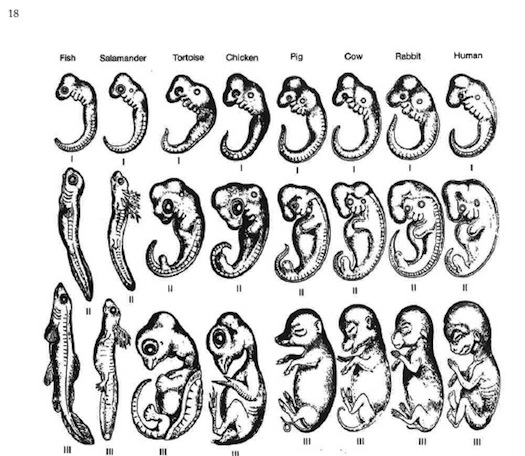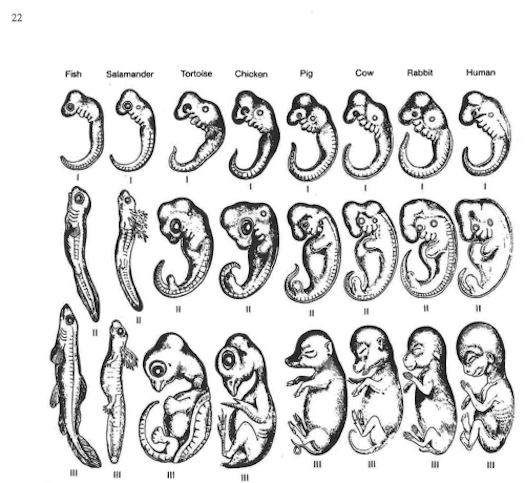 Evolution
Evolution
Textbooks by Our Critic Donald Prothero Are Some of the Most Recent to Reprint Phony Embryo Drawings
The name Donald Prothero may ring a bell with you — I responded to his comments on Stephen Meyer’s book Darwin’s Doubt last week. But Dr. Prothero, a geologist and prominent “skeptic,” has a long history of interaction with Darwin-doubters.
In January, I wrote about how Prothero had accused Discovery Institute of “fakery and incompetence” after we published a video interview with a green-screen shot showing biologist Ann Gauger in a biology lab.
My response to the strange attempt by Prothero and others to manufacture a scandal out of this was simple:
- Ahem.
- Ann Gauger works in a biology lab.
- Where she does research related to the theory of intelligent design.
- Just about everyone involved in making videos on a budget uses green-screen shots sometimes. It’s a convenient way of setting a speaker against a relevant background, when filming in an actual location would be complicated, expensive, and less conducive to an interview.
- Ergo no scandal.
Interestingly, it turned out that Dr. Prothero has some personal experience with promoting “fakery”: he has reprinted Haeckel’s embryo drawings in his textbooks for the express purpose of promoting evolution — the very same drawings that have been called “fakes” and “fraudulent” by leading evolutionary scientists.
At that time, I referred to one example from a textbook published in 1994 by Prothero and Robert H. Dott, which I used for an evolution course during my freshman year in college. Since this past January, I’ve discovered more examples of Prothero’s textbooks that use Haeckel’s drawings. Recently I had occasion to look through Prothero’s 1998 textbook Bringing Fossils to Life, which I used later in my undergraduate and graduate studies of paleontology. Here is Haeckel’s embryo drawings in Prothero’s 1998 textbook, p. 18:
As in his other textbook that I reviewed, the embryo drawings are used for the purpose of promoting the idea of common descent. They are not there simply to provide historical context, which might be acceptable if the problems with the drawings were candidly acknowledged. The caption, however, is nothing like that:
Embryos of different vertebrates at comparable stages of development (top row) are strikingly similar in every group, regardless of their adult anatomy. Note that each embryo begins with a similar number of gill arches (pouches below the head) and similar vertebral column. In the later stages of development, these structures are modified to yield a variety of different adults forms. (From Romanes, 1910, after Haeckel.)
(Donald Prothero, Bringing Fossils to Life: An Introduction to Paleobiology (McGraw-Hill, 1st edition, 1998), p. 18.)
Neither the caption nor the body in Prothero’s textbook mentions the inaccuracies in Haeckel’s drawings. On the contrary, the caption highlights the most inaccurate aspects of the drawings, without acknowledging as much, to demonstrate the supposed fact that embryos are “strikingly similar” in their earliest stages. The text then goes on to promote a slightly altered version of “ontogeny recapitulates phylogeny,” very much as in Prother’s 1994 textbook.
Now it turns out there’s an even more recent example of Haeckel’s embryos in Prothero’s textbooks. It’s the second edition of Prothero’s Bringing Fossils to Life, published in 2004. Yes, it includes the same old inaccurate drawings (p. 22):
The caption is identical to the one in his 1998 textbook, and once again, there’s no indication in the text that the drawings are inaccurate, or that these are being presented for the sake of establishing historical context. Rather, once more, they are supposed to show how early vertebrate embryos are “highly similar,” thus confirming the notion of common descent.
Now, there are textbooks still more recent than Prothero’s that reprint Haeckel’s embryo drawings — for example, 2010 and 2011 texts by Sylvia Mader. However, Mader’s books don’t use exact reprints of the old black-and-white drawings, but instead opt for colorized versions that are otherwise nearly identical to the old fakes. Prothero’s textbooks, by contrast, use the original black and white drawings of Haeckel’s embryos, as printed in Romanes (1910).
This gives Donald Prothero the distinction of having authored some of the most recent textbooks to reprint Haeckel’s original drawings for the purpose of promoting Darwinian thinking.
